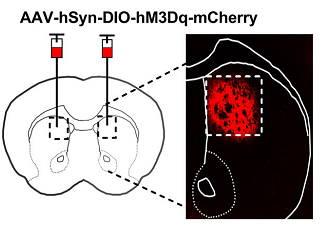AAV-hM3Dq(Gq) and AAV-hM4Di(Gi) were used for chemogenetic experiment. (From
BrainVTA)
The viruses used in this article from BrainVTA are in the table below
|
Chemogenetics |
PT-0019 AAV-hSyn-DIO-hM3Dq(Gq)-mCherry
PT-0020 AAV-hSyn-DIO-hM4Di(Gi)-mCherry |
|
Control |
PT-0115 AAV-hSyn-DIO-mCherry |
Zhijun Diao, Yuanyuan Di, Meilin Wu, Chenyang Zhai, Mengsi Kang, Yongfeng Li, Yingxun Liu, Chunling Wei, Qiaohua Zheng, Jing Han, Zhiqiang Liu, Yingfang Tian, Wei Ren
Pub Date: 2021-04-27,
DOI: 10.1007/s12264-021-00687-8,
Email: sales@brainvta.com
Plasticity in the glutamatergic synapses on striatal medium spiny neurons (MSNs) is not only essential for behavioral adaptation but also extremely vulnerable to drugs of abuse. Modulation on these synapses by even a single exposure to an addictive drug may interfere with the plasticity required by behavioral learning and thus produce impairment. In the present work, we found that the negative reinforcement learning, escaping mild foot-shocks by correct nose-poking, was impaired by a single in vivo exposure to 20 mg/kg cocaine 24 h before the learning in mice. Either a single exposure to cocaine or reinforcement learning potentiates the glutamatergic synapses on MSNs expressing the striatal dopamine 1 (D1) receptor (D1-MSNs). However, 24 h after the cocaine exposure, the potentiation required for reinforcement learning was disrupted. Specific manipulation of the activity of striatal D1-MSNs in D1-cre mice demonstrated that activation of these MSNs impaired reinforcement learning in normal D1-cre mice, but inhibition of these neurons reversed the reinforcement learning impairment induced by cocaine. The results suggest that cocaine potentiates the activity of direct pathway neurons in the dorsomedial striatum and this potentiation might disrupt the potentiation produced during and required for reinforcement learning.
 Figure 1. Injection site of AAV-DIO-hM3Dq-mCherry virus in the DMS.
Figure 1. Injection site of AAV-DIO-hM3Dq-mCherry virus in the DMS.
In this study, the authors reported that cocaine potentiates the activity of direct pathway neurons in the dorsomedial striatum and this potentiation might disrupt the potentiation produced during and required for reinforcement learning.
BrainVTA offers viral vector construction & virus packaging services for AAV, LV, RABV, PRV, HSV and VSV that help researchers explore questions about genes, neurons, circuitry structure, function of brain network, mechanism and treatment of diseases.
If you have any needs, just email us at
sales@brainvta.com.
